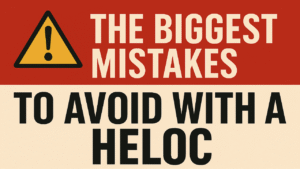 The Biggest Mistakes to Avoid with a HELOC
The Biggest Mistakes to Avoid with a HELOC
A Home Equity Line of Credit (HELOC) can be a smart financial tool for homeowners looking to tap into the value of their property. Whether you’re funding home improvements, consolidating debt, or covering unexpected expenses, a HELOC offers flexibility and relatively low interest rates. But with great power comes great responsibility—and misusing a HELOC can lead to serious financial consequences. In this article we will show you the biggest mistakes to avoid with a HELOC.
You can make informed decisions and protect your home and financial future.
💸 1. Using Your HELOC for Non-Essential Spending
One of the most common pitfalls is treating a HELOC like a credit card. Because it offers revolving access to funds, it’s tempting to use it for vacations, luxury purchases, or impulse buys. But unlike a credit card, your home is the collateral.
Why it’s risky:
If you default on your HELOC payments, you could lose your home. Using borrowed equity for non-essential spending turns your house into an ATM—and that’s a dangerous mindset.
Better strategy:
Reserve HELOC funds for value-adding expenses like home renovations, education, or strategic investments.
📉 2. Borrowing More Than You Can Afford
HELOCs often come with generous credit limits, especially if your home has appreciated in value. But just because you can borrow more doesn’t mean you should.
Why it’s risky:
Overextending yourself can lead to financial strain, especially if your income changes or interest rates rise. Many borrowers underestimate how quickly debt can accumulate when they’re drawing from a flexible line of credit.
Better strategy:
Create a detailed budget and repayment plan before accessing your HELOC. Only borrow what you can comfortably repay—even if your lender offers more.
📈 3. Ignoring Variable Interest Rates
Most HELOCs come with variable interest rates, which means your monthly payments can fluctuate over time. If rates rise significantly, your payments could become unaffordable.
Why it’s risky:
A sudden spike in interest rates can derail your budget and increase your debt load. Many borrowers are caught off guard when their payments jump unexpectedly.
Better strategy:
Ask your lender about rate caps and consider locking in a fixed rate if available. Always build a buffer into your budget to accommodate potential rate increases.
📄 4. Not Reading the Fine Print
HELOC agreements can be complex, with terms that vary widely between lenders. Draw periods, repayment schedules, fees, and penalties are often buried in the fine print.
Why it’s risky:
Failing to understand the terms can lead to surprises—like balloon payments, early repayment penalties, or unexpected fees.
Better strategy:
Read your HELOC agreement carefully and ask questions. Make sure you understand the draw period (typically 5–10 years), the repayment phase, and any associated costs.
🧾 5. Applying with a Low Credit Score
Your credit score plays a major role in determining your HELOC interest rate and approval terms. Applying with poor credit can result in higher rates and less favorable conditions.
Why it’s risky:
Higher interest rates mean higher monthly payments and more money spent over the life of the loan.
Better strategy:
Check your credit score before applying. If it’s below 700, consider improving it by paying down debt and correcting any errors on your credit report.
🛒 6. Failing to Shop Around
Not all HELOCs are created equal. Rates, fees, and terms can vary significantly between lenders, and choosing the wrong one can cost you thousands.
Why it’s risky:
Settling for the first offer may mean missing out on better rates or more flexible repayment options.
Better strategy:
Compare offers from at least three lenders. Look beyond interest rates—consider fees, draw periods, repayment terms, and customer service reputation.
🧮 7. Misunderstanding Tax Implications
Many homeowners assume that HELOC interest is tax-deductible. While this can be true, it only applies if the funds are used to buy, build, or substantially improve your home.
Why it’s risky:
Using your HELOC for other purposes—like paying off credit card debt or funding a wedding—won’t qualify for tax deductions. Misreporting this on your taxes can lead to penalties.
Better strategy:
Consult a tax professional before claiming deductions. Keep detailed records of how HELOC funds are used to support your claims.
🧯 8. Using a HELOC to Cover Everyday Expenses
If you’re relying on a HELOC to pay bills or cover basic living costs, it may be a sign of deeper financial trouble.
Why it’s risky:
Using home equity to stay afloat can create a cycle of debt that’s hard to escape. If your financial situation worsens, you could lose your home.
Better strategy:
Explore other options first—such as budgeting assistance, debt consolidation, or financial counseling. A HELOC should be a strategic tool, not a lifeline.
The Biggest Mistakes to Avoid with a HELOC: Final Thoughts
A HELOC can be a powerful way to leverage your home’s equity, but it’s not without risks. By avoiding these common mistakes, you can use your HELOC to enhance your financial stability—not jeopardize it.
Key takeaways:
- Treat your HELOC like a serious loan, not a casual credit line.
- Borrow with purpose and a clear repayment plan.
- Understand the terms, rates, and tax implications before signing.
If you’re considering a HELOC, take the time to evaluate your goals, compare lenders, and consult with financial professionals. Your home is one of your most valuable assets—protect it by making smart, informed decision.